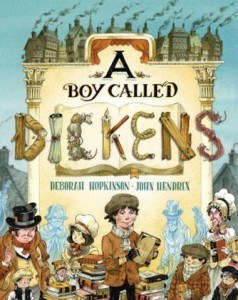I originally picked up this picture book thinking it would be a biography. Sherry and I are always working on expanding our popular session Historical Fusions, and so we are continuously searching for quality biographies to add to our collection.
Why I Finished It:
This book is different from any I have read before. As the reader, you are pulled along and almost encouraged to interact. Every so often, you are spoken to directly as the reader: “Come along, now. We are here to search for a boy called Dickens.” This picture book is complex, with beautiful language, with a smidgen of creative storytelling. It wasn’t until the end that I realized this story is fictional! In the author’s note, we are told that Dickens was quite secretive and his story hasn’t been fully revealed. This story takes pieces of known information and bits of his works of art to make a possible story of his life. Even though I was hoping for a biography, this made me even more intrigued.
Who I Would Give It To:
All lovers of literature and story telling needs this story! As an educator, it needs to be in every upper elementary/middle school classroom writing teacher’s class.
Integration Ideas:
Research and Biography Ideas:
Even though this is a fictional story and not a biography, you could find the articles and true facts from his life to find out the true parts and what parts are fictional. This would be a great time for students to read one of Dickens novels, such as Oliver Twist or David Copperfield, and have students figure out what parts mirrored his true life. Students could research information about him to see what sparked or inspired him to write his novels. You could set up your own Google Search Engine with some of these links: BBC Biography, Literature Network, and Dickens in Context. Or check out some of these other search engines that are student friendly!
Writing Workshop:
Throughout this story, Dickens sees his imagination come to life. He is sharing stories orally and thinking about how people he knows become stories. This is exactly what we want students to do in their own writing. Take small moments and create a story, see events as a story, create and share stories. Have students create characters from people they know, exaggerate some of their features, and think about their personality. Use this story as a mentor text. Have students discuss how people from his real life became fictional characters in his stories. Have students emulate this in their own imaginative story.
Sensory Language and Visualization:
This book has beautiful language. Have students close their eyes and picture, using the five senses, what they are visualizing. Ask the students why the author chose to use this type of language and how it helps the reader understand what they are reading. An example, “The fog has crept in, silent as a ghost, to fold the city in cold, gray arms.” Once the students have discussed the visual this sentence provides, use this same sentence as a mentor text for writing. Discuss word choice, why did the author use the word crept. What does crept make you think about? Why didn’t the author say the fog swung in? Or the fog darted in? Continue to break the sentence apart. Many things are silent, why did the author choose ghost when talking about fog? Continue the discussion and the purposeful word choice. Have students go to their own writing and find a sentence. Ask students to add purposeful word choice to their sentence.
Technology option: Using a tool like Nearpod, read a sentence aloud and have students draw what they see on their device. The tool will allow you to capture their drawings digitally. After students have had a chance to visualize, change one of the words (swung instead of crept) and have the students draw again. See how the word choice makes a difference!
Notable Websites:
Author’s Site: Deborah Hopkinson
Illustrators Site: John Hendrix
Technology Integration
This would be a great opportunity to have students create a dual timeline to track events from either this book or one of Dickens’ works alongside the known events from Dickens’ life. Using a tool like Prezi or Popplet, you can have students work in groups to research and compile information, putting the author’s work and life in context.







Leave a Reply